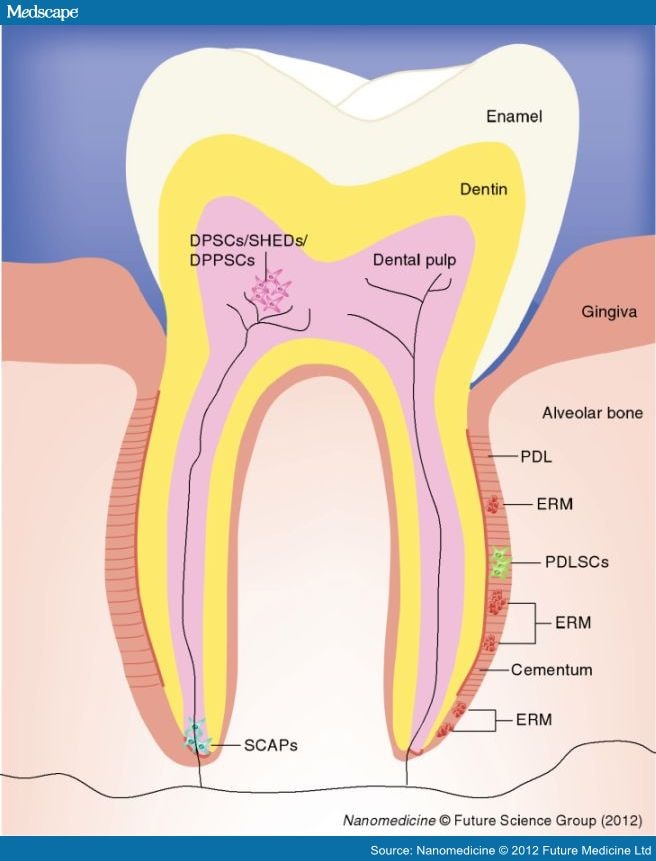Stem Cell Populations Within Dental & Periodontal Tissues
Stem cells are undifferentiated cells characterized by their ability to self-replicate throughout life and their capacity to differentiate into diverse specialized cell types.[5] Adult stem cells are found in various tissues of the human body of both epithelial and mesenchymal origin, including skin,[6] adipose tissue,[7] periosteum[8] and cartilage.[9] Owing to their ability to give rise to every cell type in a given tissue, adult stem cells are responsible for tissue/organ homeostasis and regeneration.
Mesenchymal stem cells have been isolated from different locations within adult or postnatal dental tissues. Dental mesenchymal stem cells have been isolated from the pulp of adult teeth (dental pulp stem cells [DPSCs]) and deciduous teeth,[10] the apical part of dental papilla,[11,12] the dental follicle[13] and the PDL (Figure 1).[14,15] All these dental stem cell populations express typical mesenchymal stem cell markers such as STRO-1, MUC-18 or Cd146, and Cd44,[16] but some of them also express other markers including Cd90, Cd73, Cd29 and Cd24.[11,17] However, the marker or combination of markers that reliably identifies dental stem cells has not been established yet. Thus, dental mesenchymal stem cells are often recognized by their ability to give rise to odontogenic,[10,16,18–21] adipogenic,[16,22] chondrogenic,[22] osteogenic,[23] myogenic[24] and neurogenic[16,25] lineages in vitro or to regenerate dental tissues in vivo.[11,17]
Figure 1.
The various dental stem populations within an adult human tooth.
DPPSC: Dental pulp pluripotent stem cell; DPSC: Dental pulp stem cell; ERM: Epithelial cell rest of Malassez; PDL: Periodontal ligament; PDLSC: Periodontal ligament stem cell; SCAP: Stem cell from the apical papilla; SHED: Stem cell from human exfoliated deciduous teeth.
Since most dental epithelial cells disappear shortly after tooth eruption, identifying epithelial stem cells within adult dental tissues constitutes a major challenge. Putative epithelial stem cell populations have been isolated from third molars[26] and, most surprisingly, dental pulp.[27] However, to date, ERM located in the PDL (Figure 1), appear as the more promising source of epithelial stem cells.[28,29]
Recently, pluripotent stem cells, named dental pulp pluripotent stem cells, have been isolated from the dental pulp of third molars.[30] These cells show the ability to differentiate into tissues that derive from embryonic mesodermal, endodermal and ectodermal layers, suggesting their potential utility for the regeneration of both epithelial and mesenchymal dental tissues.
Nanomedicine. 2012;7(11):1743-1753. © 2012 Future Medicine Ltd.









